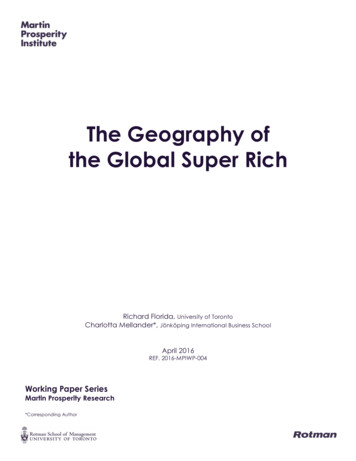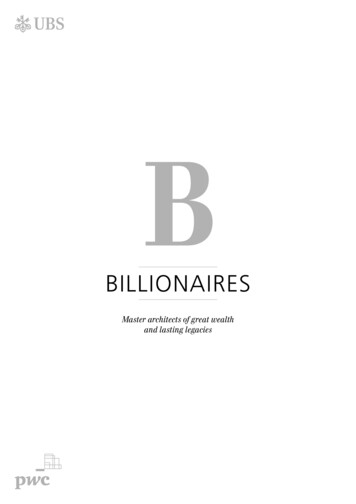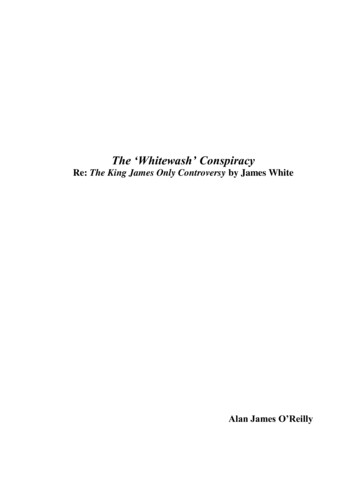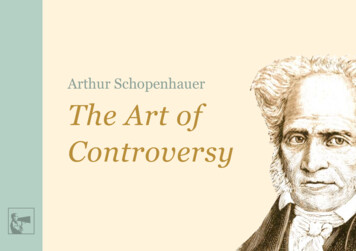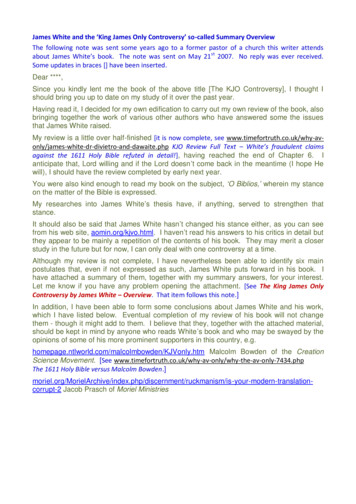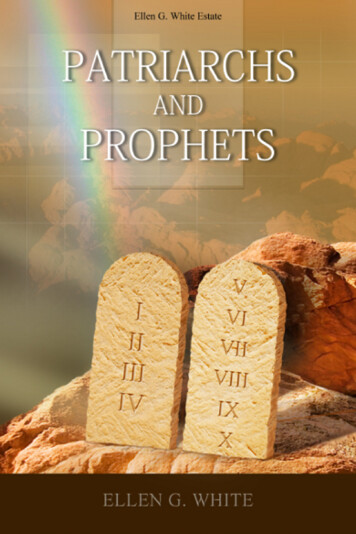
Transcription
1The Controversy over Billionairesat the time of his reelection campaign , several conservativebillionaires were unhappy with the job performance of PresidentBarack Obama. The economy was not doing well. There wasuncertainty in foreign policy. Many of them believed that Obamawas a poor leader. Irate about how things were going, they decidedto devote several hundred million dollars to defeating the president.Individuals such as Sheldon Adelson, David and Charles Koch, andthe late Harold Simmons and a group of wealthy donors assembledby Republican strategist Karl Rove felt that they needed to speakout to ensure that the country had stronger leadership and movedin what they considered a better d irection.But they were not the only super-wealthy people who werepolitically active. In recent elections, there has been an explosionof activism by the rich. Billionaires such as Michael Bloomberg,George Soros, and Tom Steyer have poured extensive resourcesinto supporting their favored candidates and causes. In addition,wealthy individuals have bankrolled advocacy campaigns at thestate level— for example, in support of same-sex marriage and marijuana legalization or in opposition to Obama’s health care reformand higher taxes on the wealthy. Aided by friendly Supreme Courtrulings and the rising cost of election campaigns, affluent people12582-4 West CS5 final.indd 16/26/14 2:36 PM
2The Controversy over Billionaireshave discovered that they are in a strong position to affect a varietyof different issues.In researching this subject, I discovered that it is not just anAmerican development but something that is happening globally. Billionaires have run for office in Austria, Australia, France,Georgia, India, Italy, Lebanon, the Philippines, Russia, Thailand,Ukraine, and the United Kingdom as well as the United States.Most of them have won. Oligarchs in Russia, so-called “princelings” in China, and tycoons in many other countries are becomingpolitically active and affecting public policy. Their political involvement raises important questions about excessive influence, especially in places where there is weak rule of law, overt corruption,and limited opportunities for social or economic advancement. Theactivism of the super rich is taking place against a backdrop ofpoor transparency, weak news coverage, accountability problems,and performance challenges on many different fronts in politicalsystems around the world. With the “wealthification” of politics,those in the upper echelon, who as a group hold policy views thatdiffer significantly from those of the general population, have accessto many ways to influence the political p rocess.Wealth— its uses and its abuses— is a subject that has intriguedme since my youth in the rural Midwest. I was born on a dairy farmand grew up poor. When asked what our house was like when myparents moved to Ohio in 1947, my mother said, “There was norunning water in it or hot water of any kind. No bathroom.” Waterwas carried in from the barn. It was not until 1952, two yearsbefore I was born, that the house got cold running water. Indeed,because of the cows, the barn had running water before our housedid. To do the laundry, Mom heated water on a gas stove, washedthe clothes in a manual washer, ran them through a hand-crankedwringer, and then hung them on a line outside to dry. She didn’thave an automatic dryer until much later in her life. Hot runningwater and an indoor bathroom were added in 1960, when I was sixyears old; the bathroom replaced the outhouse that the family had2582-4 West CS5 final.indd 26/26/14 2:36 PM
The Controversy over Billionaires3used before. In 1965, we got a furnace to replace the coal stoves inthe kitchen and living r oom.The contrast between the poverty of my youth and the privilegeof my adulthood makes me very attuned to the role that wealthypeople play in the United States and around the world. Not onlyhas it made me curious about the lives of the rich, it has led me toask questions regarding their political impact. The world’s billionaires have had a major influence on other people. They have creatednew businesses, launched new products, and altered how peoplelive, work, play, and c ommunicate.Yet much of the current debate regarding the political role ofbillionaires suffers from ideological short-sightedness. Progressivesfear political activism when it is undertaken by conservative billionaires yet applaud it when liberal billionaires swing into action.Conservatives get worried when left-leaning billionaires dump a lotof money into elections but appreciate the advocacy efforts of theirown billionaires and pro-business special interest groups. Whateach side misses are the challenges raised by billionaire activism forthe system as a whole. Billionaires’ extensive resources and advocacy efforts provoke questions about political influence, transparency, and accountability. At a time of high income concentrationand dysfunctional political institutions, it is important to understand the impact that the ultra rich have on national life and theneed for policies that promote better disclosure, governance, and opportunity.Here, too, I have a personal perspective. From my perches in boththe Ivy League, at Brown University, and the Brookings Institution,I have seen Americans of great wealth do positive things with theirmoney and improve the lives of other people. Most of those that Iknow personally display admirable traits— vision, innovativeness,and entrepreneurship. Moreover, having received research grantsfrom leading foundations as well as people of great wealth overa number of years, I have benefited professionally from their philanthropy. Some of those discussed in this book are or have been2582-4 West CS5 final.indd 36/26/14 2:36 PM
4The Controversy over Billionairesbenefactors of Brown and others of Brookings, and they are identified as such. Their careers and practices illustrate different themesand observations, but what they have in common is a respect forinstitutional independence, academic freedom, and public transparency regarding sources of f unding.It is possible to admire individual billionaires but also feartheir overall influence on elections, governance, and public policy.According to Forbes magazine, there are 1,645 known billionairesaround the world, 492 of whom live in the United States. In thisbook, I study their political efforts in the United States and othercountries and describe how they have pioneered more activist formsof politics and philanthropy. I argue that such activism presentsmajor challenges in the areas of political influence, accountability,transparency, and system performance. Countries everywhere needpolicies that promote better disclosure and governance and preserveopportunities for a broader range of p eople.Income ConcentrationThe assets of the U.S. super wealthy— as reported on the Forbeslist of billionaires— have more than doubled over the past decade.Ten years ago, these individuals controlled around 1 trillion; nowtheir wealth has risen to more than 2 trillion.1 Economists MarcoCagetti and Mariacristina De Nardi show that 1 percent of Americans now own about one-third of the country’s w ealth.2Economists Thomas Piketty and Emmanuel Saez document howincome concentration has risen over the past century. Figure 1-1charts the share of pre-tax income accounted for by the top 1 percent of earners from 1913 to 2012.3 In 1928, the year before theGreat Depression, that group garnered 21.1 percent of all income inthe United States. Over the next 50 years, that percentage droppedto a low of 8.3 percent in 1976, then rose to 21.5 percent in 2007.It dropped to 18.8 percent in 2011 following the Great Recession,then rose again to 19.6 percent in 2012.4 Those figures show thatincome concentration today is similar to what it was in the 1920s2582-4 West CS5 final.indd 46/26/14 2:36 PM
The Controversy over Billionaires5Figure 1-1. Pre-Tax Income Received by Top One Percent, 501958196619741982199019982006Source: Thomas Piketty and Emmanuel Saez, “Income Inequality in the United States,1913–1998,” Quarterly Journal of Economics, vol. 118 (2003), pp. 1–39. For 1999 to 2012numbers, see the web page of Emmanuel Saez (http://emlab.berkeley.edu/users/saez).and is more than double the degree during the post–World War II period.More detailed statistics demonstrate that after-tax income stagnated for most workers from 1979 to 2009 but rose dramaticallyfor the top 1 percent. Charting the percent change in real after-taxincome for four groups of workers shows that during those 30years, earnings rose 155 percent for the top 1 percent of earners,58 percent for the next 19 percent of earners, 45 percent for themiddle 60 percent, and 37 percent for the bottom 20 percent.5 Andif a recent book by Thomas Piketty, Capital in the Twenty-FirstCentury, is correct, money is likely to become even more concentrated in the future. Drawing on data from several countries overthe past 200 years, he argues that the appreciation of capital outpaces that of the economy at large and of wages in particular. Thatbenefits the people who already hold a lot of financial resources andincreases the overall concentration of w ealth.6Still another way to look at the income gap relies on the Ginicoefficient, an economic measure developed in 1912 by the Italiansociologist Corrado Gini that is used to express inequality among2582-4 West CS5 final.indd 56/26/14 2:36 PM
6The Controversy over Billionairesdifferent income levels. It runs from 0 to 1; 0 indicates that everyone has the same income, and 1 indicates that one person has allthe income. The Gini coefficient for the United States was around.38 in 1950, dropped to .35 around 1970, and rose to .45 in 2010,7demonstrating that financial inequality has increased substantiallyover the past 60 y ears.Alex Cobham and Andy Sumner of the Center for Global Development have proposed a new metric that they call the Palma ratio,after economist Gabriel Palma, who argues that it is important thatthe “middle 50 percent” remain stable to ensure a society’s social,economic, and political well-being. The Palma ratio compares theshare of national income held by the top 10 percent of householdswith the share held by the bottom 40 percent. The authors find thatthe United States ranks forty-fourth among 86 countries in termsof inequality, a rank that makes U.S. inequality worse than that ofvirtually every other developed n ation.8As a sign of how profound income divisions have become, increasing inequality has widened the gaps between different social groups.Over the past 25 years, the financial gulf between whites and blackshas nearly tripled. In 1984, the difference in wealth between theraces was 85,000; by 2009, it had increased to 236,500. Thegaps in homeownership, education level, and financial inheritanceare responsible for most of these differences; for example, according to researchers, the “home ownership rate for whites is 28 percent higher than that of blacks.”9 As Jennifer Hochschild and hercollaborators at Harvard University point out, policymakers needto think seriously about the impact of these trends on social cohesion and political r epresentation.10Financial concentration has increased not just in the UnitedStates but in many other countries around the globe. Research byThomas Piketty and Gabriel Zucman finds that wealth has risenmuch more rapidly than incomes in eight developed nations: theUnited States, Britain, France, Germany, Italy, Canada, Australia,and Japan. They find that “wealth-to-income ratios in these nations2582-4 West CS5 final.indd 66/26/14 2:36 PM
The Controversy over Billionaires7climbed from a range of 200 to 300 percent in 1970 to a range of400 to 600 percent in 2010”—a doubling of the wealth concentration over that time p eriod.11The reality of inequality has generated considerable attention inmany countries. In Russia and Eastern Europe, the super wealthy,who profited enormously from the cheap sell-off of state-ownedenterprises following the fall of communism, are derided as “oligarchs.” In China, the children of prominent Communist Partyleaders, who are able to accumulate extensive wealth by using theirfamily connections, are known as “princelings.” A study undertakenby the China Family Panel Studies program at Peking Universitythat examined 14,960 households in five leading Chinese provincesfound that the top 5 percent earned 23 percent of the nation’s totalincome. In addition, the top 25 percent in those provinces earned59 percent of total income while the bottom quarter earned only 3.9percent. That gave those areas a Gini coefficient of . 49.12Despite those numbers, one Chinese billionaire downplays thedangers of income differentials. “We don’t need to solve the problem of the rich-poor gap, we need to solve the problem of commonprosperity,” said Zong Qinghou, one of the richest men in China.He has a great fortune, which he earned from companies that sellsoft drinks, milk for babies, and children’s clothing. “If we hadegalitarianism, we wouldn’t have enough to eat,” he said. In anargument that would resonate with many conservative politiciansin the United States, he claimed that the best way to create wealthin China is to lower taxes in order to stimulate financial investmentand economic growth.13 However, at least one migrant worker inChina did not take kindly to his remarks. Shortly after they werepublicized in the media, Zong was attacked by a knife-wieldingjobseeker in Hangzhou. Some tendons in one of Zong’s hands werecut, but otherwise the billionaire was not seriously h armed.14Looking at the world as a whole, the United Nations WorldInstitute for Development Economics Research showed that in2008, the top 1 percent of earners owned a total of 40.1 percent2582-4 West CS5 final.indd 76/26/14 2:36 PM
8The Controversy over BillionairesFigure 1-2. Global Inequality, 002Source: Branko Milanovic, “Global Inequality and the Global Inequality Extraction Ratio:The Story of the Past Two Centuries,” World Bank, September 2009 13-9450-5044).of overall global wealth, a share that is larger than the one-third ofnational wealth owned by the top 1 percent in the United States.15As shown in figure 1-2, the Gini coefficient for global income hasincreased substantially over the past two centuries. According toWorld Bank economist Branko Milanovic, inequality rose from .43in 1820, .53 in 1850, and .56 in 1870 to .61 in 1913, .62 in 1929,.64 in 1960, .66 in 1980, and .71 in 2 002.16Political Activism of the WealthyThe wealthy are much more politically active than the generalpublic. In a “first-ever” public policy survey funded by the RussellSage Foundation of “economically successful Americans,” political scientists Benjamin Page, Larry Bartels, and Jason Seawrightmeasured the activism and beliefs of the rich. They worked withthe Wealthfinder “rank A” list of the top 2 percent of Americanhouseholds based on wealth and supplemented it with an ExecuReach list of high-level business executives of major companies.In order to reach their intended population, they screened for thetop “1% of wealth-holders” and completed interviews with thoseindividuals.17 In talking with them, the researchers found that 992582-4 West CS5 final.indd 86/26/14 2:36 PM
The Controversy over Billionaires9percent of the wealthy said that they voted in presidential elections,almost double the rate of the general public. Most (84 percent) alsoreported paying close attention to politics. Two-thirds (68 percent)made campaign contributions to politicians; in stark contrast, only14 percent of the general public d oes.18The reason is clear. Wealthy people know that political engagement matters.19 Being involved in politics yields benefits and enablesthem to express their views and influence results. Unlike the general public, which tends to be cynical about politics, believing thatthere is no difference between Republicans and Democrats and thatpolitics is not a very good way to produce change, many affluentpeople seem to believe that politics matters and represents a way toaffect national and international affairs. Indeed, a study by political scientist Lee Drutman of the top 1,000 campaign donors from2012 (those who gave at least 134,000) found that two-thirdsfavored Republicans and the largest number of them came fromthe financial sector.20Given the importance of engagement, it is not surprising that thewealthy report in this survey a large number of “high-level politicalcontacts.” When asked whether they had contacted public officialsor their staffs in the last six months, 40 percent indicated that theyhad contacted a U.S. senator; 37 percent, a U.S. House member;21 percent, a regulatory official; 14 percent, someone in the executive branch; and 12 percent, a White House official.21 Those ratesare much higher than the rates for the general public. A nationalsurvey undertaken at the University of Michigan documented thatabout 20 percent of ordinary people said that they had contacted amember of the U.S. Senate or House in the preceding four years,22through telephone calls, letters, or visits to legislative o ffices.Distinctive Views of the WealthyIt is important to analyze wealth in democratic systems because thesuper rich, as a group, hold policy views that are significantly different from those of ordinary citizens. In their survey, Page, Bartels,2582-4 West CS5 final.indd 96/26/14 2:36 PM
10The Controversy over BillionairesTable 1-1. Views of the Wealthy and the General PublicPercent in agreementThe wealthy(top 1 percent)GeneralpublicI favor cuts in Medicare, education, andhighways to reduce budget deficits.5827Government has an essential role in regulating the market.5571Government should spend what is necessary to ensure that all children have goodpublic schools.3587I’m willing to pay more in taxes to providehealth coverage for all.4159Government should provide a decent standard of living for the unemployed.2350Government should provide jobs for everyone willing to work who can’t find a privatesector job.853ViewSource: Benjamin Page, Larry Bartels, and Jason Seawright, “Democracy and thePolicy Preferences of Wealthy Americans,” Perspectives on Politics, vol. 11 (March 2013).and Seawright asked the wealthy about a range of public policyissues.23 Comparing their opinions with those of the general public,the researchers found that top wealth holders “differ rather sharplyfrom the American public on a number of important policies. Forexample, there are significant differences on issues such as taxation,economic regulation, and social welfare programs.”24 Table 1-1summarizes the gulf in policy preferences between the top 1 percent and the general public. The wealthy are more likely than thegeneral public to favor cuts in Medicare and education (58 percentversus 27 percent for the public), while they are less likely thanthe public to believe that the government has an essential role inregulating the market (55 percent versus 71 percent, respectively).2582-4 West CS5 final.indd 106/26/14 2:36 PM
The Controversy over Billionaires11Most surprising, however, are the differences in views about socialopportunities. In the abstract, it might be assumed that there wouldbe little gap in this area. According to the Credit Suisse GlobalWealth Databook, two-thirds (69 percent) of wealthy individualscame from humble origins and conceivably could favor a limitedgovernment role in the economy but still value equity of opportunity.25 But that is not what Page, Bartels, and Seawright found intheir survey. Their data show that while 87 percent of the generalpublic believed that the government should spend whatever is necessary to ensure that all children have good public schools, only 35percent of the top 1 percent did.26 The wealthy also were less likelythan the general public to want the government to provide jobs ifprivate sector positions are unavailable, to believe the governmentshould provide a decent standard of living for the unemployed, orto be willing to pay more taxes to support universal health c are.This research indicates that those with great resources are farmore conservative than the public on a range of issues related tosocial opportunity, education, and health care. They do not supporta major role for the public sector, even when government actionsfurther economic and social opportunities for the general public.They are much more likely to favor cuts in social benefits and programs that benefit less fortunate members of society. These views ofthe super rich lead them to favor tax cuts— even though they reducethe financial resources to invest in education and health care— and to place more emphasis on deficit reduction than on “pumppriming” that stimulates economic growth. If politically active richpeople favor tax cuts and support austerity measures, as has beenthe case in recent years, it is difficult to generate political supportfor programs that help the nation’s low- and middle-income peoplebetter themselves.The “Get a Senator” StrategyIt is no accident that the Page, Bartels, and Seawright survey ofthe wealthy finds them seeking influence most frequently through2582-4 West CS5 final.indd 116/26/14 2:36 PM
12The Controversy over Billionairesmembers of the U.S. Senate. Because of Senate rules granting unbridled authority to individual senators to block nominations throughsecret holds, object to “unanimous consent” motions, and engagein filibusters (that is, block action through unlimited debate), apopular tactic among those with extensive political connectionsis to develop a close relationship with a senator who sits on a keycommittee or who can exercise influence in other ways and persuade that person to block undesired nominations or b ills.Holds can be used to stop legislation that a senator doesn’t like.Senator Rand Paul (R-Kentucky), for example, has been unhappywith a proposed treaty that would force Swiss banks to releasethe names of 22,000 wealthy Americans who have hidden an estimated 10 billion in offshore accounts. Even though the treatylikely would win the approval of the Senate as a whole, for severalyears he single-handedly has prevented action because he believesthat the new rules would permit the invasion of people’s p rivacy.27Through what one wealthy individual described to me as the“get a senator” strategy, a person needs to obtain the support ofonly a single member to prevent the chamber from a taking particular action. In a system of fragmented political institutions characterized by decentralized decisionmaking and multiple veto points,having a senator who acts on one’s behalf is an effective way to stymie unwanted government action or delay appointments affectingparticular industries. Along with lobbyists representing businessesand other vested interests, those who are rich and connected canstop measures that they deem detrimental to their pocketbooks.For decades, if not centuries, the political ramifications of greatwealth have provided cartoonists with inspiration and material, asillustrated by the New Yorker cartoon reprinted b elow.Billionaires sometimes enlist senators to write letters to federalregulators asking for investigations of other companies. An example of this came to light in the case of hedge fund manager William Ackman, of Pershing Square Capital Management. For years,the billionaire financier has run a campaign against the nutritional2582-4 West CS5 final.indd 126/26/14 2:36 PM
13 Barbara Smaller/The New Yorker Collection/The Cartoon BankThe Controversy over Billionairessupplement firm Herbalife, alleging that its sales practices amountto an illegal pyramid scheme. Ackman has invested 1 billion in hisbelief that the company is overvalued.28 Not content with drawinghis own conclusions regarding the business practices of Herbalife,he persuaded Senator Edward Markey (D-Massachusetts) to writeletters to the Securities and Exchange Commission and the FederalTrade Commission criticizing the firm and demanding a formalinvestigation. Ackman personally lobbied Markey’s staff and hireda Markey aide to join his lobbying team. As soon as Markey’s letterwas made public, the Herbalife stock price dropped by 14 percent,partly achieving the billionaire’s g oals.According to Princeton sociologist Martin Gilens, influence peddling is not rare. His analysis indicates that there is a strong link2582-4 West CS5 final.indd 136/26/14 2:36 PM
14The Controversy over Billionairesbetween “affluence and influence.” Through a detailed analysisof policymaking, public opinion, and income levels, he demonstrates that “affluent Americans’ preferences exhibit a substantial[positive] relationship with policy outcomes whether their preferences are shared by lower-income groups or not.” He argues thatthere is “virtually no relationship between policy outcomes andthe desires of less advantaged groups” when the preferences ofthe latter diverge from those of the wealthy.29 And in a follow-upstudy with Benjamin Page, Gilens examined the impact of average citizens and economic elites on 1,779 policy issues over thepast 30 years and concluded that ordinary people had “little orno independent influence.”30 The issue of distinctive political influence was brought home to me when I met my first billionaire atBrown University, where I taught political science. A Rhode Islandbusinessman named John Hazen White Sr. had endowed a lectureseries, and we invited legendary broadcaster Ted Turner, who hadattended the university three decades earlier, to speak. Although hehad been kicked out in the 1960s for disciplinary code violationsinvolving alcohol and women, years later Brown had awarded himan honorary degree in recognition of his development of CNN, thefirst all-news cable network. Pleased with the honor, Turner hadfunded a faculty position and pledged a multimillion dollar gift tothe school (he also has been a Brookings donor). That made himwhat Brown euphemistically called a “friend” of the u niversity.Accompanied by his then-wife, Jane Fonda, he came to campusin 1995 to give a lecture about the environment entitled “Our Common Future.” Turner was alternately serious, funny, and outrageous.He explained the importance of the environment to the future ofhumanity and talked about why he was raising buffalo on his hugeMontana ranch. Then, in an unexpected twist, he joked that what hereally liked about living in the West was being able to “take a whiz”off his front porch. The Ivy League audience laughed u proariously.Turning back to his broader message, he related the lessons ofhis life. His most difficult challenge, he said, had been making the2582-4 West CS5 final.indd 146/26/14 2:36 PM
The Controversy over Billionaires15first million dollars; after that, everything was easy. Money begetsmoney, he bluntly observed, thereby making it possible to gain evengreater wealth through social and political connections. That, ofcourse, is the crux of the controversy about the role of billionairesin society. Wealth in and of itself is not problematic. It is how richpeople convert financial might into political power for their ownbenefit that creates p roblems.Transparency ProblemsIt is perfectly reasonable for rich people to express their views,lobby Congress, and attempt to influence elections as long as others are aware of what they are doing and can organize accordingly.Even if the wealthy have more money than other people, openness helps protect the general population and allows the public toassess the actions of the wealthy. The problem, however, is thatmany efforts to exercise influence have migrated behind the scenesand often are invisible to the news media or general public. As aresult of court rulings that treat “freedom to spend” as equivalentto “freedom of speech,” campaign finance has become much moresecretive. Wealthy interests can fund advocacy organizations withno disclosure of their contributions r equired.These kinds of judicial decisions bias the political process infavor of the ultra rich. Former GOP presidential candidate NewtGingrich, whose super PAC received 15 million from billionaireSheldon Adelson, notes the extraordinary importance of the rich incontemporary elections. “Whether it’s the Koch brothers or Soroson the left or Sheldon, if you’re going to have an election processthat radically favors billionaires and is discriminating against themiddle class— which we now have— then billionaires are going toget a lot of attention,” he o bserved.31Wealthy people across the political spectrum have pioneerednew activist models of political involvement that combine electioneering, issue advocacy, and philanthropy. They pursue influence through interlocking networks of foundations, grassroots2582-4 West CS5 final.indd 156/26/14 2:36 PM
16The Controversy over Billionairesorganizations, tax-exempt groups, and super PACs (political actioncommittees, independent committees that can raise unlimitedamounts of money). Dubbed by reporters as the “Koch model,”after conservative billionaire activists Charles and David Koch, thisapproach now is being emulated by liberal billionaires Tom Steyerand George Soros (who also have donated to Brookings) as well asby businessman and former New York City mayor Michael Bloomberg, among others. Rich people like this approach because “it’sadaptive, data-driven, and they [the Kochs] are the most propitiouscapital allocators in political activism.” 32The combination of wealth and secrecy, however, is toxic todemocratic systems. In the realm of political persuasion, the messenger can count as much as the message. Voters need to know whois behin
1 1 The Controversy over Billionaires at the time of his reelection campaign, several conservativ

